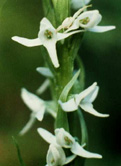Platanthera dilatata (Pursh) Lindley ex Beck
Tall white bog-orchid, bog candles
The specific epithet dilatata is the Latin meaning "dilated,"
in reference to the dilated base of the labellum in this species.


Photos courtesy of Bill Alverson
DESCRIPTION: Plant glabrous,
arising from a cluster of fleshy, thickened roots, 10-90+ cm tall. Leaves
2-5, lanceolate to elliptic-lanceolate, gradually reduced to linear-lanceolate
bracts higher up on the stem, 5-25 cm long and 1-6 cm wide, ascending. Inflorescence
a loose or dense raceme, 10-70 flowered; flowers snowy white, each flower
subtended by a lance-linear, acuminate bract. Lateral sepals lanceolate
to elliptic-lanceolate, 4-8 mm long and 1.5-3 mm wide, spreading to reflexed,
colored as flowers; dorsal sepal ovate, 3-6 mm long and 2-4 mm wide,
connivent with petals over the column, colored as flowers. Petals
lanceolate to linear-lanceolate, falcate, 3-8 mm long and 1-2 mm wide, connivent
with the dorsal sepal over the column, colored as flowers. Labellum
linear-lanceolate and abruptly dilated at the base, obtuse, 5-10 mm long
and 2-5 mm wide, colored as flowers, base of labellum with a +/- clubbed
nectar spur projecting behind, 5-10 mm long.
SIMILAR SPECIES: Platanthera dilatata is easily confused with
P. hyperborea. This problem is exacerbated
by the fact that the two hybridize freely, and produce intermediate offspring.
Specimens that are not easily assigned to either one species or the other
are probably introgressants, and may be impossible to determine. Representative
specimens of the two taxa can be separated by the shape of the labellum,
which is strongly dilated at the base in P. dilatata, and only weakly
so in P. hyperborea.
HABITAT: Platanthera dilatata has a preference for circumneutral
soils, and is usually found in Thuja bogs and fens. It is also occasionally
found growing in more acid situations in bogs.
FLOWERING DATES: June 25-July 15.
POLLINATION: Kipping (1971) observed
noctuid moths pollinating Platanthera dilatata var. leucostachys
in California. Since variety leucostachys differs from variety dilatata
only in the length of the spur (loner than the labellum in variety leucostachys,
shorter than the labellum in variety dilatata), it is likely that noctuids
also pollinate P. dilatata in Wisconsin.
WI DISTRIBUTION:  U.S. DISTRIBUTION:
U.S. DISTRIBUTION:
Go directly to Wisconsin herbarium records.
Return
to the main LIST of the Orchids of Wisconsin.
Return to the main KEY to the Orchids of
Wisconsin.


 U.S. DISTRIBUTION:
U.S. DISTRIBUTION: